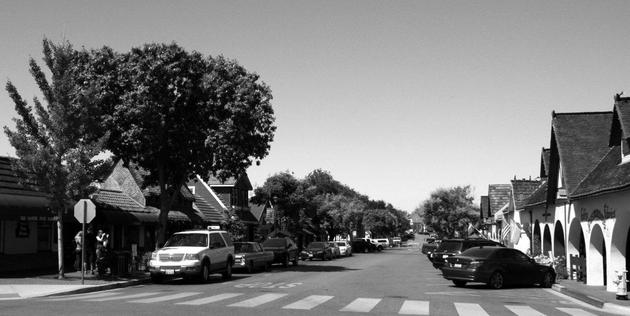
History
In October 1910 Reverend Benedict Nordentoft, Reverend J.M. Gregerson and Professor P.P. Hornsyld along with other like-minded Danes formed the Danish American Colony Corporation in the State of California. In January 1911 the company bought 8,882 acres of land in the Santa Ynez Valley adjacent to Mission Santa Ines circa 1840. They purchased land for $338,000 which is approximately $38.00 an acre. The contract specified that the Danish American Colony would sell $100,000 worth of land a year to new settlers. Later that same year, Reverend Gregerson would become the president of the Danish American Colony board of directors which immediately set out to attract new settlers. They would sell land priced from $25. – $130. per acre. The first 33 acres was sold to Dr. P. Soe in February 1911.
Building began and by July 1911 the Solvang Hotel was ready for business. As people started to build barns and houses, in that order, new businesses were established as well.
Many people made their living as dairy farmers which was a traditional occupation in Denmark as well as growing crops in the fertile soil of the Santa Ynez Valley. By 1950 though farming was on the decline with the very last dairy closing in 2003.
Some of the earliest business in Solvang included; In 1911 Sophus Olsen built the first general store, In 1912 Marcus Nielsen built a creamery which operated until 1920, The Santa Ynez Valley Bank opened in 1913 with a capital of $25,000 and Solvangs first newspaper, the Santa Ynez Valley News was published on December 11, 1925. The newspaper survives to this day.

Solvang’s Main Street in 1919 was a dirt road lined with small, mostly wooden buildings designed in a nondescript Western frontier style. Horse and buggies competed with an increasing number of cars. The flag pole put up in 1918 at the intersection of First and Main Streets to honor World War I veterans can be seen slightly to the left center. In the far background is Dania Hall, a community hall built in 1913 by Solvang members of the Danish fraternal organization. To the right is Marcus Neilsen’s general store. In 1914, Neilson bought out Sophus Olsen’s general merchandise store (Solvang’s first store).

The Solvang Business Men’s Association was founded in 1921 to promote the welfare of the community. This association urged the paving of what was then called Main St., now Copenhagen Drive. The Association also helped establish a volunteer fire department and to bring the first doctor to town. In addition, the Association published a promotional booklet in 1930 targeting the tourist, an early step to attract visitors to the community. Most far-reaching of all, they celebrated the 25th Anniversary of the founding of Solvang with a grand party called Danish Days. This event attracted crowds of 30,000 to 40,000 who came to Solvang to help celebrate. What is now known as Danish Days was the first major event that attracted visitors to come to Solvang. The second major event was a 1947 Saturday Evening Post article with color illustrations highlighting the folk dancers at a Danish Day celebration. This article brought in visitors once again to take part in the festivities.The Solvang Municipal Improvement District (SMID) was founded in 1951. This organization was the forerunner of the City of Solvang and made some important contributions to Solvang. By a special act of the California legislature, it consolidated the Fire District, The Lighting District, and the Sanitary District and replaced Solvang Water Works which had been supplying water to the community since 1918. In 2012 the City of Solvang celebrated its 27th birthday having incorporated in 1985.
The Solvang Chamber of Commerce, like the business organizations that had come before, continues to provide a united and powerful voice for business.

